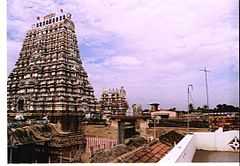Tirupperunturai
| Avudaiyarkoil | |
|---|---|
 | |
 Avudaiyarkoil Location in Tamil Nadu | |
| Geography | |
| Coordinates | 10°05′N 78°35′E / 10.09°N 78.59°ECoordinates: 10°05′N 78°35′E / 10.09°N 78.59°E |
| Country | India |
| State | Tamil Nadu |
| District | Pudukkottai |
| Location | India |
| Culture | |
| Primary deity | Athmanathar(Shiva) |
| Architecture | |
| Architectural styles | Dravidian architecture |
Tirupperunthurai (Tamil: திருபெருந்துறை), known as Avudaiyarkoil.,[1][2][3][4][5] is a Shaiva temple situated near Aranthangi in the Pudukkottai district of Tamil Nadu. One of the sacred books of Tamil Saiva Siddhanta, Manikkavacakar's Tiruvacakam, originated from this shrine. Manikkavacakar is said to have converted the king to the religion of Shiva and built the temple with money that had been intended for war-horses.[6]
The Temple
The presiding deity is formless (Atmanatar); there is no Shivalingam but only a pedestal {Avudayar} located in the sanctum, hence the name Avudayar Koil.[7] His consort is worshipped as Siva Yoga Nayaki in iconless form. There is no Nandi bull icon. There is deep spiritual significance in the queerness. Hinduism allows deity worship only for beginners in the initial stage. As the devotee and his devotion matures, he has to realise the truth of formless. To illustrate the theology, the temple has been designed. This is the only Saivite shrine in whole of India to portray the supreme truth symbolically. Since the soul(athma) has no form, the deity is called Athmanathar.[8] The Temple is located at the co-ordinates of 10.076°N 79.043°E.
Administration
As at Chidambaram and Tiruvanaikoil, here Vedic rituals are performed, unlike the Sivachariyar or Adhisaivar temples who follow Agama rituals. in this case the temple is administered by Nambiar Brahmins – a class of Vaideeka Brahmins said to be descendants of Rowshayadana, a saint who originated from Agni, and were taught the Vedas by Atmanatar himself. They are said to number three hundred and are also called Munnothioruvar.
At Tirupperunthurai, as in Chidambaram temple, Aruvam (அருவம்.. அதாவது உருவமற்ற கடவுள் நிலை) is worshipped. Tirupperunthurai is also known as Kokozhi, Sivapuram, Akasha Kailasham, Vadavoor, Chatur-Veda-Mangalam and Adi Kailasam in Sangam literature and Atheetha Sabha as it has six Sabhas, the Kanaka Sabha, Chit Sabha, Sat Sabha, Ananda Sabha, Ratna Sabha and Deva Sabha in comparison to five Sabhas at Chidambaram. It is believed that Manikkavacakar himself built these six sabhas, and covered the Sabhas with 21600 plates of copper.
Legend
The temple is supposed to have been built by Manickavasagar. Being the prime minister, he spent all the money given to him by the Varaguna Pandya II king to buy horses in building the temple.[9] As he was bereft of money, Lord Shiva displayed one of his Thiruvilayadal(holy prank) by transforming foxes to horses and once they were given to the king became foxes.
Architecture
The temple is noted for the zephyr(granite) roof work. The ceiling of the Kanga sabhai(golden hall) is a grandeur creation in stone. The ropes, rafters and nails all are made of granite.[10] The bow wielding Muruga, Kali and Siva's rudra thandavam(wild dance) are the finest specimen in sculptural art.
Many renovations have been carried out, much of the current structure dates to the fifteenth CCE. The temple covers an area of over 10 acres (40,000 m2) and faces south, constructed so that the setting sun strikes the sanctum even though it is cloistered within three circumambulatory paths. The thousand pillared hall has several delicately crafted pillars with depictions of the Oordhwa Tandavam of Shiva, Kaaraikkaal Ammaiyaar, Dhanurdhara Subramanya etc.
Festival
The annual festivals celebrated here are Aani Tirumanjanam and Maargazhi Tiruvaadirai as in Chidambaram Nataraja Temple. Worship or Pooja is done six times a day.
References
- ↑ "New inscriptions confirm Manickavasagar built temple". thehindu.com. Retrieved 2014-02-03.
- ↑ http://tnmaps.tn.nic.in/vill.php?dcode=22¢code=0009&tlkname=Avudayarkoil%20%20332209
- ↑ http://pudukkottai.nic.in/taluks-avkoil.htm
- ↑ http://tnmaps.tn.nic.in/district.php
- ↑ http://pudukkottai.nic.in/blocks-avkoil.htm
- ↑ Das, Sisir Kumar; Akademi, Sahitya (1991). A History of Indian Literature. Sahitya Akademi. p. 574. ISBN 81-7201-006-0. Retrieved 2008-06-01.
- ↑ Smith, David (2003). The Dance of Siva: Religion, Art and Poetry in South India. Cambridge University Press. p. 230. ISBN 0-521-52865-8. Retrieved 2008-06-01.
- ↑ Tourist Guide to Tamil Nadu
- ↑ Footprint India.Roma Bradnock
- ↑ Concise classified dictionary of Hinduism.Kodayanallur Vanamamalai Soundara Rajan
| |||||||||||||||||||||||||||||||||||||||||
